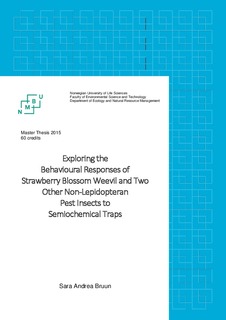| dc.description.abstract | Among the major pest insects of North-European berries are the strawberry blossom weevil Anthonomus rubi (Coleoptera: Curculionidae), the European tarnished plant bug Lygus rugulipennis (Hemiptera: Miridae), and the raspberry beetle Byturus tomentosus (Coleoptera: Byturidae). Softpest Multitrap is an organic research project aiming to decrease damage by these species, through optimal use of semiocehemical traps for mass trapping. The overall objective of this thesis was to contribute with more knowledge of behavioural responses to cross-vane funnel bucket traps baited with species-specific lures, focusing on A. rubi.
The damage of A. rubi was assessed across several distances (0-12.30 m) from traps baited with lures (aggregation pheromones, plant volatile or both), in a field study. The objective was to see whether a “spillover” from the traps could be detected and whether this was affected by attractant used as lure. The results showed a significant increase in damage with distance from traps, thus dismissing the spillover hypothesis. Few weevils were caught, thus indicating the results were caused by too high release rate of the lures. The highest level of damage was around traps baited with aggregation pheromones alone and together with plant volatile, indicating a female preference for these lures.
The second objective was to learn how the trap work, how A. rubi behave on traps and how trap properties (lure and vane colour) and individual behaviour affects the capture process and rate. A. rubi behaviour on traps baited with aggregation pheromones, plant volatile or both, was documented by direct observations. Data from previous studies of L. rugulipennis and B. tomentosus was re-analysed. Estimated capture rate (i.e. percentage of individuals on trap that fell through the funnel and into the bucket) was low for all (2.7% for A. rubi). The probability of capture did not increase with time on trap for any of the three species. Most fell during the first five minutes on trap while others stayed for many more minutes without falling. This indicates individual differences in condition or the insects get increasingly used to the surface. Overwintered A. rubi were more restless than the new generation, which might affect the lower capture rates reported previously. Lure and vane colour had no effect on A. rubi on trap, suggesting their only role is attracting the individuals to the trap. The vanes were the area most occupied by all species which is an advantage for capture. Disadvantages discovered were too broad vanes with 20% stretching outside of the funnel opening, and the outer edges seemed to induce flight. Suggestions on how to improve trap design are narrower vanes, a more slippery vane surface, a slippery inner funnel, and a smoother junction between bucket and funnel part to ease the way for insects climbing from the ground. | nb_NO |

